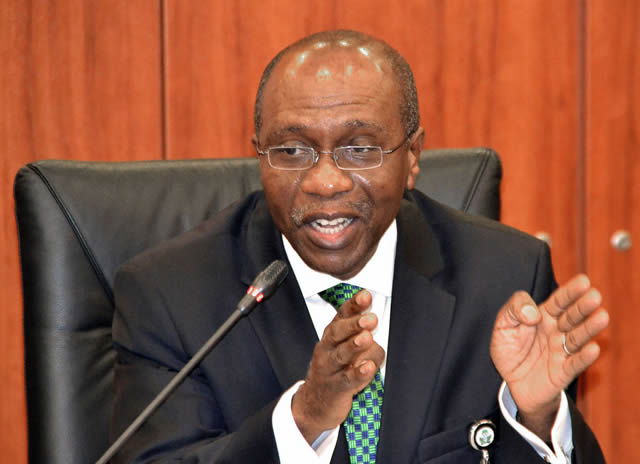Markets
CBN and Real Sector Intervention
Published
6 years agoon

- CBN and Real Sector Intervention
Globally, the relationship between the financial system and real sector development remains very critical for any economy to realise its potential.
No economy can grow and improve the living standards of its population in the absence of credit to the real sector.
That is why the real sector depends largely on the flow of funds from the banking system.
Many economists have acknowledged that the financial system, with banks as its major component, provide linkages for the different sectors of the economy and encourage high level of specialisation, expertise, economies of scale and a conducive environment for the implementation of various economic policies of government intended to achieve non-inflationary growth, exchange rate stability, balance of payments equilibrium and high levels of employment.
Well-functioning financial systems can mobilise household savings, allocate resources efficiently, diversify risk, enhance the flow of liquidityand reduce information asymmetry.
However, in Nigeria, because of the high level of risk in the system, a lot of commercial banks have remained apathetic towards lending and havebeen largely criticised for this.
That is why in addition to its core functions, the Central Bank of Nigeria (CBN) has over the years performed some major development financefunctions, focused on key sectors of the Nigerian economy.
That was why at its July 2018 Monetary Policy Committee (MPC), the CBN had emphasised the need to increase the flow of credit to the real sector of the economy to consolidate and sustain economic recovery.
To achieve this objective, the central bank had also stated that banks would henceforth be incentivised to direct affordable, long-term bank credit to the manufacturing, agriculture, as well as other sectors considered as employment and growth stimulating.
This clearly was why its guidelines for accessing the Real Sector Support Facility (RSSF) through Cash Reserve Requirements (CRR) and Corporate Bonds (CBs) was released last Thursday.
The New Guidelines
In the RSSF, the CBN clearly pointed out that activities to be covered under the programme would be Greenfield (new) and expansion (Brownfield) projects in manufacturing, agriculture and other related sectors approved by the CBN.
It, however, stated that emphasis would be placed on Greenfield projects.
It prohibited operators involved in trading activities from accessing its real sector support facility and warned banks that attempt to “falsify through presentation of projects that do not meet the eligibility criteria/specified terms and conditions shall attract severe penalties”.
The facility shall have minimum tenor of seven years and two years moratorium. Also, participating financial institution (PFI) shall bear the credit risk.
But under the new guidelines, the CBN pointed out that banks interested in providing credit financing to Greenfield (new) and Brownfield (new/expansion) projects in the real sector (agriculture and manufacturing) may request the release of funds from their CRR to finance the projects, subject to the bank providing verifiable evidence that the funds shall be directed at the projects approved by the CBN.
Also, it stressed that refinancing of existing loans is prohibited for funding under the programme, saying that any attempt to falsify information would also attract severe sanctions.
It stated: “This programme involves investment by the CBN and the general public in CBs issued by Corporate subject to the intensified transparency requirements for Triple A-rated entities.
“Such requirements would include publishing through printing of an Information Memorandum spelling out the details of the projects for which the funds are required together with terms and conditions showing that these are long term projects that are employment and growth stimulating.”
The new guidelines stressed that priority would be accorded projects with high local content, import substitution, foreign exchange earnings and potential for job creation.
According to the CBN, the objectives of the facility includes to improve access to affordable finance to the manufacturing, agricultural, and other related sectors that are employment and growth stimulating to the economy.
In addition, it is aimed at stimulating growth in employment-elastic sectors.
Providing insights into the differentiated CRR (DCRR) system, the guidelines stated: “It shall comprise loans to Greenfield or expansion projects using CRR. Emphasis shall, however, be on new projects.”
In terms of CBs, which are financing instruments issued by corporates that meet eligibility criteria as specified by the CBN, the tenor shall be as specified in the prospectus by the issuing corporate but not below seven years. Also, the moratorium for such CBs shall be as specified in the prospectus by the issuing corporate.
It specified: “The maximum facility shall be N10 billion per project. Facilities are to be administered at an all-in interest rate/charge of 9 per cent per annum. Bank customers are encouraged to report any bank to the CBN’s Director of Banking Supervision, where such DMB may have charged interest rates above the prescribed maximum of nine percent per annum.
“Repayments shall be amortised and remitted on quarterly basis to the CBN.
“Only CRR contributing DMBs shall be eligible to participate under the DCRR. For CBs, all financial institutions and general public are eligible to participate in investing in CBs.”
Boost for Economic Recovery
Analysts at CSL Stockbrokers Limited commended the CBN’s efforts to support the sluggish recovery in the economy.
They, however, noted that the fundamental structural and socio-economic issues limiting banks from increasing their risk appetite for lending to the real sector needs to be addressed.
“Incessant clashes between farmers and herdsmen in the “food basket states” as well as the widening infrastructure deficit (particularly power and road) will continue to hinder the productivity of the real sectors.
“That said, if the programme is well implemented, it should ease the liquidity squeeze in the real sectors, providing the finance required for expanding capacity, and ultimately stimulating economic growth,” the Lagos-based investment bank stated.
Also, the Director General, Lagos Chamber of Commerce and Industry (LCCI), Mr. Muda Yusuf, described the initiative a positive development, saying it would help increase the flow of credit to the private sector.
“It is a very good initiative by the CBN. As service sector players, we have always canvased for low interest rate and have always complained about high interest rate for businesses.
“Each time the Monetary Policy Committee met, they kept tightening the benchmark interest rate which meant that the cost of borrowing would remain high.
So, the issue of adjusted CRR is an innovative approach which would help to boost investment through low-cost funds and longer tenor funds as well. So, it is a good initiative,” he added.
But, Yusuf appealed to the CBN to also design such intervention schemes for other sectors of the economy, which according to him needs support.
He listed such sectors to include the service, construction, maritime, transportation, healthcare, education, entertainment and tourism sectors.
“All these sectors also bring value to the economy and generate employment. So, we need to look beyond the agriculture and manufacturing sectors, because these other sectors are also adding value and they also need funding.
“The guidelines also said the funds cannot be used for refinancing, but only for greenfield and brownfield. But my appeal to the CBN also is that existing investors are as important as new investors.
“If anything, I think we need to get those who are already in business to be properly on their feet. We need to stabilise them and support them to be more productive, to accelerate the economic recovery process.
“Many of the firms are under the heavy burden of debt servicing which is very costly. So, I don’t see anything wrong in easing the pressure for them with this kind of facility.
“So, I don’t support the idea of excluding them completely from the facility,” the LCCI boss stated.
Also, the Managing Director, Cowry Assets Management Limited, Mr Johnson Chukwu, welcomed the initiative, saying it would help unlock the flow of credit.
Commenting on the adjusted CRR initiative, he said, “In principle, it is avery creative initiative. It may not completely address the issue of the real sector, but it will would help towards improving the performance of firms.
“The reality is that it is hard for the real sector operators to be payinginterest of between 22 to 25 percent and remain profitable.
“So, to give them loan at nine per cent is quite creative and will certainly ease their problems.”
Chukwu, however, stressed the need for the monetary policy and the fiscal policy authorities to continue to work towards achieving single digit interest rate in the economy and not just for real sector operators.
Is the CEO and Founder of Investors King Limited. He is a seasoned foreign exchange research analyst and a published author on Yahoo Finance, Business Insider, Nasdaq, Entrepreneur.com, Investorplace, and other prominent platforms. With over two decades of experience in global financial markets, Olukoya is well-recognized in the industry.

You may like
-


Zhongshang Fucheng Moves to Auction Nigerian Properties in UK Following $70M Arbitration Award
-


Nigerians and Indians Lead UK Job Market Growth Amid Post-Brexit Migration Shifts
-


Violent Protests Erupt Across Nigeria, Leaving Six Dead and Many Injured
-


Nigerian President Tinubu Condemns Protest Plans Over Economic Woes
-


Nigeria to Suspend Import Levies on Food Crops to Ease Inflation Pressure
-


Nigeria Leads Africa in Private Equity Deals, Records $2.59 Billion in Q1 2024








